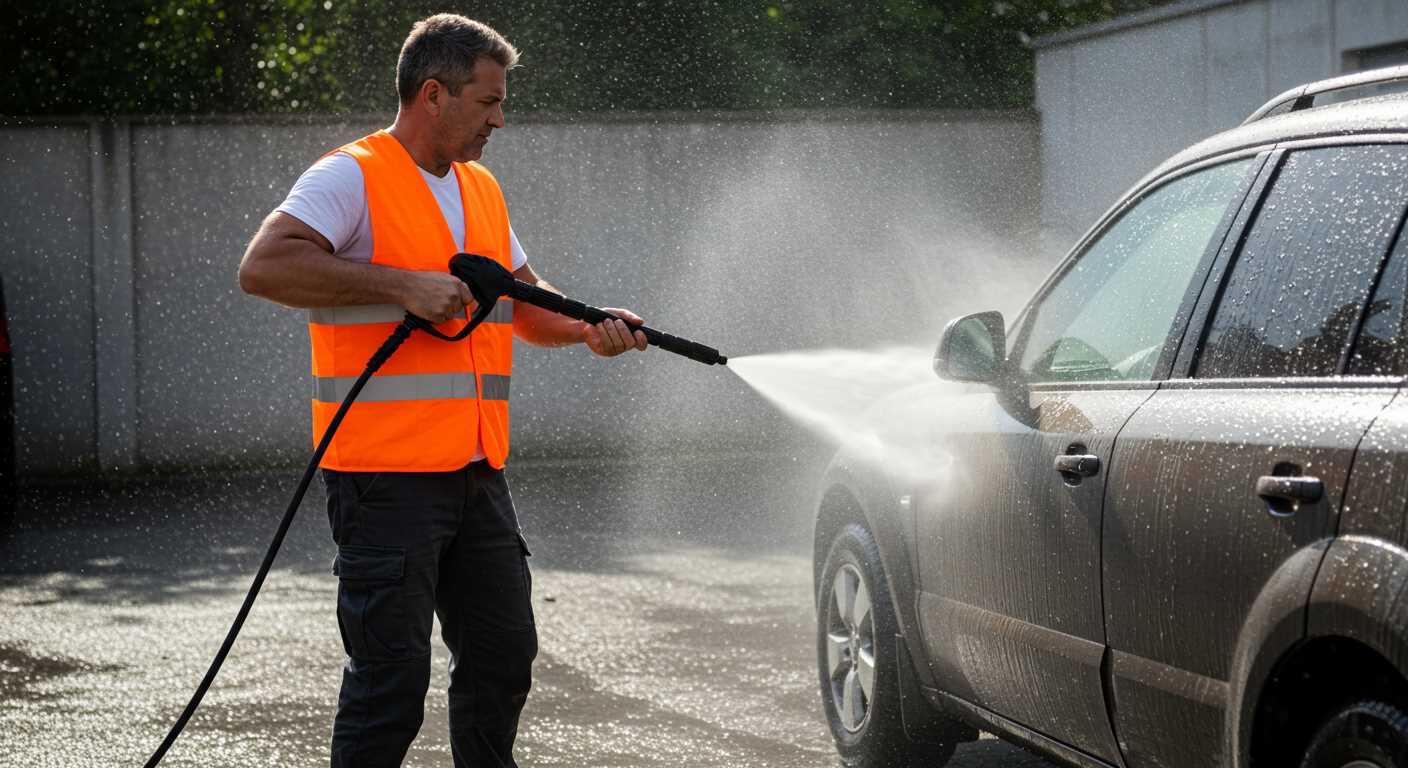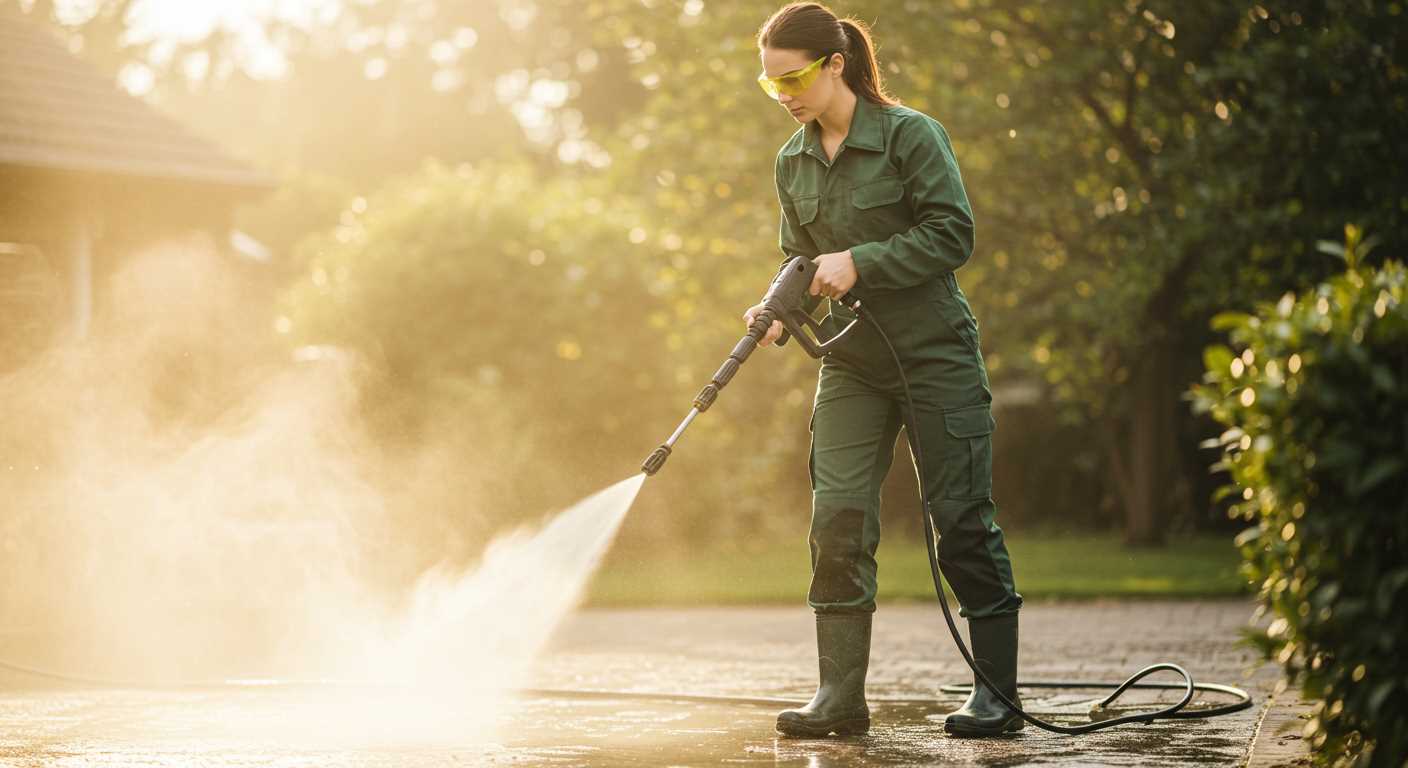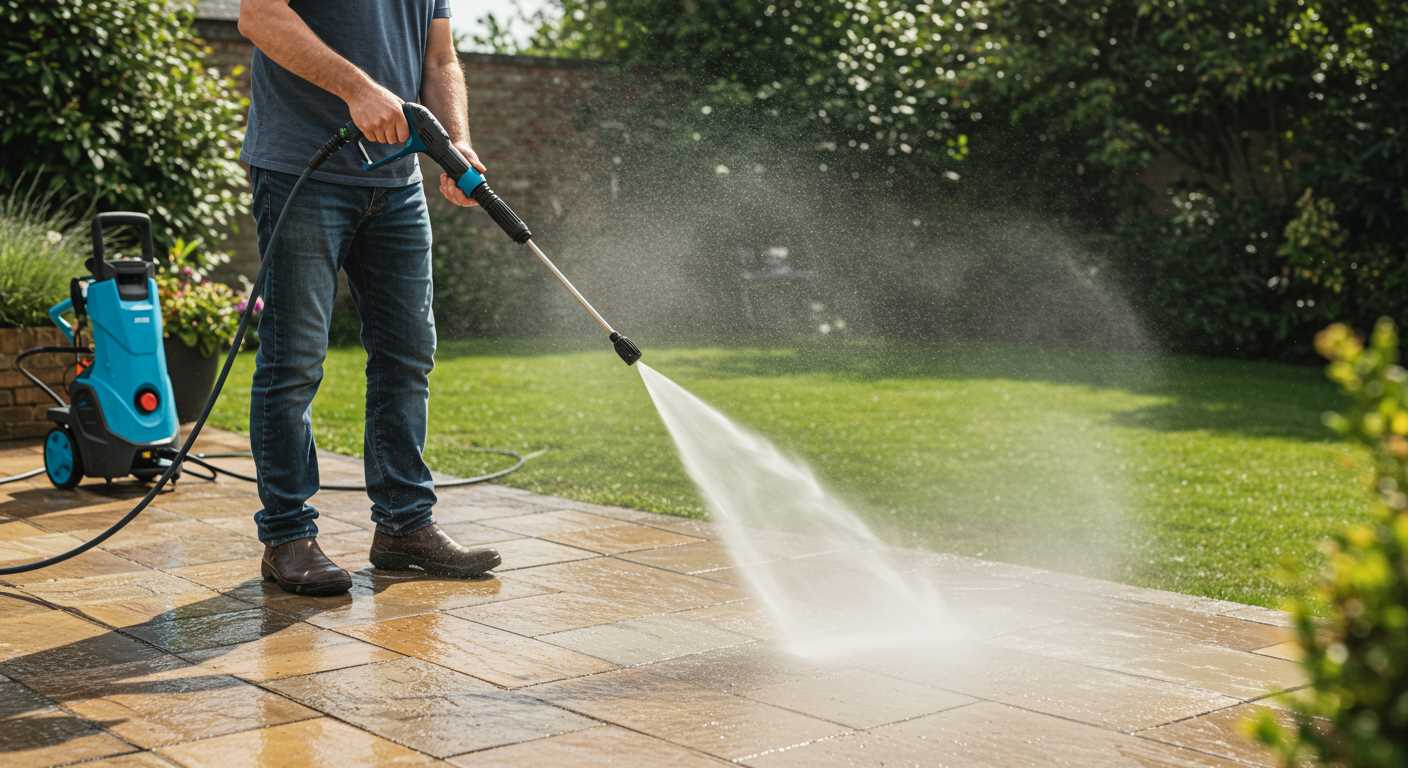



Utilising a high-powered cleaning device can significantly enhance your success in tackling greasy marks on concrete or asphalt. My extensive experience in the cleaning equipment industry has shown that selecting the right nozzle and pressure level is crucial for optimal results. For best outcomes, a 25-degree or 40-degree nozzle typically works wonders, providing enough force without causing damage to the underlying surface.
Before starting, ensure the area is well-prepared. Remove any loose debris, such as leaves and dirt, as these can obstruct the cleaning path. Adding a pre-treatment solution specifically crafted for stubborn spots can also yield impressive results when left to penetrate for about 10–15 minutes. This proactive step allows the cleaner to work deeply into the grime, ensuring that the water blast is more effective.
As you engage the motor, maintain a steady and even motion when cleansing the area. Keep the nozzle approximately 12 to 18 inches from the surface, moving in a sweeping pattern. This technique prevents concentrated pressure on one spot, which can lead to unintentional damage. After the initial pass, inspect your work and determine if further treatment is needed on particularly stubborn areas.
For persistent marks, repeating the process with a focus on those specific sections can significantly improve results. Ensure to finish with a rinse of clean water to wash away any remaining cleaning solution and loosened debris. These strategies, combined with the right equipment, will leave your surface looking clean and well-maintained.
Removing Grease Residues Using a High-Pressure Cleaner
To tackle greasy residues on concrete, start by pre-treating the affected area. I recommend utilizing an absorbent material such as cat litter or sawdust to soak up excess liquid. After allowing it to rest for a few hours, sweep away the used absorbent before proceeding.
Next, prepare your high-powered unit with a suitable detergent designed for automotive applications. Attach a rotating nozzle for optimum performance on stubborn marks. Maintain a distance of about 12 inches from the surface to prevent any damage.
Technique and Power Settings
Select a pressure setting between 2000 to 3000 PSI for concrete. Move the nozzle back and forth over the area, allowing the cleaning solution to penetrate the surface effectively. Keep your movements steady to ensure a thorough cleanse.
After scrubbing, rinse the area with clean water from the nozzle to wash away the loosened grime. Repeat the process for any remaining marks until the surface appears clean. Allow the area to dry completely before using the space again.
Final Touches

If any traces linger, apply a second round of cleaning solution and apply the power cleaner again, focusing on persistent spots. Following the cleaning, consider sealing the surface to prevent future blemishes. Regular maintenance will also aid in keeping the area looking pristine.
Choosing the Right Pressure Washer for Tackling Challenging Marks
To effectively address tough marks, opt for a unit with a minimum psi (pounds per square inch) of 3000. This pressure level provides adequate force for most persistent residues. Additionally, a flow rate of at least 4 GPM (gallons per minute) ensures that the water volume can assist in swiftly rinsing away the grime.
Types of Pressure Washers
There are two primary types available: electric and gas-powered. Electric models are convenient for lighter jobs and are quieter, while gas-powered units are more robust, making them suitable for intensive cleaning tasks.
Accessories and Detergents
Consider purchasing interchangeable nozzles to modify the spray pattern. A 25-degree nozzle is versatile for general cleaning, whereas a 15-degree nozzle offers a more concentrated stream. Additionally, using an appropriate cleaning solution can enhance the efficacy. Ensure it is safe for the surface to prevent damage.
In my experience, dedicating time to select the right equipment can make all the difference in achieving desired results swiftly and effectively. Investing wisely will save you both time and effort in the long run.
Preparing the Driveway Before Washing
Clear the area thoroughly to ensure maximum effectiveness. Remove any furniture, toys, or debris from the surface. This step creates a clean workspace, allowing persistent substances to be targeted effectively.
Next, check for any loose gravel or stones on the surface. Sweep these away to prevent them from becoming projectiles during the cleaning process, which can cause damage.
Assess the weather conditions. Ideally, choose a day with no rain forecasted for at least 24 hours post-cleaning. Direct sunlight can help the surface dry faster after treatment.
Prepare the equipment by ensuring your chosen device is in good working order. Inspect the nozzle for any clogs and verify the hose connections are secure.
It’s also smart to pre-treat the area. Select an appropriate cleaning solution specifically designed for this purpose. Apply it to heavily soiled spots ahead of time to allow it to penetrate and lift hard-to-remove residues.
- Remove obstacles from the surface.
- Clear away loose gravel to avoid damage.
- Choose a clear, dry day for cleaning.
- Check equipment functionality; ensure everything is in operating order.
- Consider pre-treating areas needing extra attention.
Selecting Appropriate Detergents for Oil Stains
For tackling tough residues, formulation choice is key. Opt for a heavy-duty degreaser that can break down grease effectively. Concentrated solutions work faster and often require less scrubbing, making the task more efficient.
Choose a product labelled for porous surfaces; this ensures better penetration and results on concrete. Environmental friendliness can also be a factor; consider biodegradable options to reduce chemical impact.
Below is a table summarising some recommended types of detergents and their characteristics:
| Detergent Type | Features | Recommended Use |
|---|---|---|
| Heavy-Duty Degreaser | Fast-acting, powerful grease-cutting | For severe build-up on driveways |
| Biodegradable Cleaner | Environmentally friendly, safe | For regular maintenance and light residues |
| Concrete Cleaner | Specifically formulated for porous surfaces | To ensure deep cleaning in specific areas |
| Alkaline Cleaner | Effective on organic materials | For general cleaning and preventive measures |
Before purchase, checking product reviews and user experiences can provide insights into effectiveness. Always follow the manufacturer’s instructions regarding dilution ratios and application methods. Testing on a small area may also reveal how well the cleaner interacts with your particular surface.
In case of tough spots, pre-treating the area with a detergent can enhance results. Let it dwell for the recommended time while keeping the surface moist, which optimises its efficacy. Rinsing thoroughly afterward assures no residue remains that could attract dirt.
Setting Up Your Pressure Washer Safely
Ensure all connections are secure prior to initiating any cleaning task. Check that the hose and sprays are firmly attached, preventing leaks that could lead to pressure loss or safety risks.
Always operate on stable ground, avoiding uneven surfaces that might cause loss of balance. Keep the workspace clear of obstacles, reducing the risk of tripping during operation.
Protective Gear

Wear appropriate safety equipment. Use goggles to shield your eyes from debris, and sturdy footwear to protect your feet. Gloves can help guard your hands against chemicals and the force of water spray.
Electrical Considerations
Utilise a GFCI (ground fault circuit interrupter) outlet for added safety. Ensure that power cords are in good condition, avoiding frayed or damaged cables. Keep electrical connections away from any water sources to prevent shorts or electrical shocks.
Maintain a safe distance from walls and vehicles, ensuring that no surfaces are harmed by the high-pressure flow. Follow the manufacturer’s instructions for specific guidelines on setup and operation.
Correct Technique for Applying Pressure Equipment
Begin by maintaining a distance of approximately 12 to 18 inches between the nozzle and the surface. This prevents potential damage while ensuring adequate cleaning. If the nozzle is too close, it may erode the material beneath.
Utilise a consistent motion while working in a straight line. Avoid lingering on one area, as this increases the risk of surface degradation. Move the nozzle side to side, overlapping each pass slightly to ensure uniform coverage.
Incorporate a sweeping technique for larger areas. This allows for efficient coverage while ensuring that no section is neglected. For stubborn spots, approach from different angles and repeat the process.
Adjust the nozzle based on the degree of cleaning required. A wider spray pattern works best for general cleaning, while a narrow jet is ideal for targeted areas with heavier residue.
Pay attention to the flow of water. Start at the highest point of the surface, allowing debris and residue to flow downwards. This method prevents re-soiling of already cleaned sections.
- Use short, controlled bursts of pressure for delicate materials.
- Gradually increase pressure only if necessary, testing on an inconspicuous spot first.
- Clean from top to bottom and left to right for maximum efficiency.
Monitor the area continuously for any missed spots and address them immediately. A final rinse with clean water can help ensure that all cleaning agents are fully removed, leaving the surface free of residues.
Dealing with Stubborn Stains: Tips and Tricks

For persistent blemishes on concrete surfaces, pre-treating the area significantly enhances effectiveness. Applying a suitable detergent or degreaser before washing helps to break down the residue. Allow it to sit for 10 to 15 minutes to penetrate the grime.
Using a scrub brush with stiff bristles can aid in loosening stubborn deposits. Focus on scrubbing the edges of the marks to ensure that the cleaning solution properly interacts with the tougher parts of the spots, making subsequent steps easier.
Temperature Matters
Utilising hot water can be advantageous. Hot water pressure units generally provide better cleaning power than cold units when tackling tenacious marks. If leveraging a hot water system, be cautious not to overheat the surface, as this can cause damage.
Technique for Maximum Impact
While washing, maintain the nozzle at a consistent distance from the surface–approximately 12 to 18 inches–to avoid damage. Use a sweeping motion rather than a concentrated blast on a single spot; this distributes pressure evenly and helps lift embedded grime without causing surface etching.
Post-Cleaning Care for Your Driveway
After achieving a refreshed surface on your concrete or asphalt, it’s crucial to apply a sealant. This protective layer enhances durability and prevents future absorption of unwanted substances. I recommend using a high-quality driveway sealant suitable for your material type.
Before applying the sealant, ensure the surface is thoroughly dry. Moisture can hinder adhesion and lead to peeling. Wait a minimum of 24 hours after cleaning to give the surface adequate time to dry, especially in humid conditions.
When applying sealant, use a roller or a sprayer to ensure an even coating. Work in sections, maintaining a consistent thickness. Overlapping strokes help avoid streaks. Allow the sealant to cure based on the manufacturer’s instructions, typically around 24 to 48 hours before vehicle traffic.
Regular maintenance aids longevity. Sweep or blow away debris before applying any cleaners or sealants. If dirt or grime builds up, a quick rinse or gentle wash can maintain the appearance. Inspect for cracks regularly; addressing minor issues immediately prevents larger repair expenses later.
Consider applying a stain-resistant treatment periodically. This additional step creates a barrier, making it more difficult for substances to penetrate the surface, preserving the aesthetic and integrity of your hardscaping.
Lastly, create a seasonal maintenance routine. Each spring and autumn, check for any wear or damage caused by weather conditions. Routine upkeep not only maintains the look but extends the lifespan of your driveway investment.
Preventing Future Oil Stains on Driveway

Applying a high-quality sealant once a year can significantly reduce the absorption of unwanted residues. This creates a protective barrier, making it tougher for any future spills to penetrate the surface.
Utilising drip pans or mats under vehicles is highly recommended. This simple measure captures leaks before they can spread, keeping the ground beneath cleaner.
Regular maintenance involves cleaning up spills immediately. Using absorbent materials like kitty litter or specialised absorbents can help contain leaks before they become problematic.
Incorporating a proper drainage system aids in directing fluids away from paved areas, reducing the risk of accumulation.
Consider positioning vehicles on gravel or dedicated parking pads. This provides an alternative surface that can handle spills without causing lasting damage.
Educating family members or anyone using the area about responsible vehicle maintenance can further minimise the incidence of leaks.
Investing in quality vehicle components, such as oil filters and hoses, reduces the chance of leaks in the first place.
FAQ:
What is the best method for removing oil stains from a driveway using a pressure washer?
The most effective method for removing oil stains involves several steps. Start by soaking the stained area with warm water to loosen the oil. Then, apply a degreaser specifically designed for concrete surfaces or a mixture of dish soap and water. Allow it to sit for about 10-15 minutes. Next, using the pressure washer, spray the area at a 45-degree angle, keeping the nozzle about 12-18 inches from the surface. This technique helps to lift the stain without damaging the concrete. After washing it away, rinse the area thoroughly to remove any residue from the degreaser.
How long does it take to remove oil stains from a driveway with a pressure washer?
The duration to remove oil stains depends on the size of the stain and the method used. Generally, the entire process can take anywhere from 30 minutes to 1 hour. This includes the time spent soaking the stain, applying the degreaser, and pressure washing the area. Larger or older stains may require more time or multiple applications of the degreaser to achieve the best results.
Can I use a home pressure washer to remove oil stains, or do I need heavy equipment?
A standard home pressure washer is typically sufficient for removing oil stains from driveways. Most residential pressure washers have enough power to tackle light to moderate stains. However, if you have a particularly stubborn or large stain, you may want to consider renting a more powerful unit or seeking assistance from a cleaning service. Always ensure your home pressure washer has the appropriate PSI (around 2000-3000 PSI) for concrete cleaning.
What preparations should I take before using a pressure washer on oil stains?
Before using a pressure washer, several preparations are advisable. First, clear the area of any debris, such as leaves and dirt, to expose the stain fully. It’s also important to check the manufacturer’s instructions for your pressure washer and the degreaser you will use. Wear protective gear, including gloves and goggles, to prevent any injury or irritation from the cleaning solutions and high-pressure water. It may also help to cover nearby plants or surfaces that you do not want to be affected by the degreaser or pressure water.
Are there any eco-friendly options for removing oil stains from driveways?
Yes, there are various eco-friendly methods for removing oil stains. You can use baking soda or cornstarch as a natural absorbent. Sprinkle either on the stain and let it sit for a few hours or overnight, then sweep it away and wash the area with water and a mixture of vinegar and dish soap. Another alternative is using a biodegradable degreaser, which can effectively lift oil stains without harming the environment. Always ensure any products used are safe for the surrounding flora and fauna.











